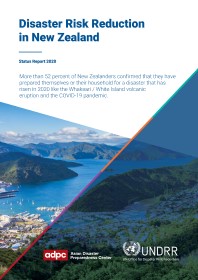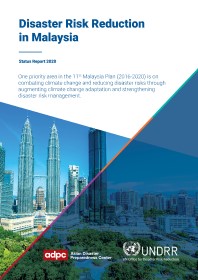- About Us
-
Who we are
-
- Publications
-
- ADPC Academy
-
MediaADPC'S NEWS
Resurfacing the Fukushima disaster Resurfacing the Fukushima disaster
17 Jan 2013
Bangkok, Thailand
On the anniversary of the Kobe earthquake, Dr. Takashi Oda (Ph.D.) spoke to members of the ADPC about his experience of the Tohoku earthquake and ensuing Fukushima nuclear meltdowns. This talk gave fascinating insight into how imminent disaster was communicated across Japan, and how reporting of the nuclear disaster caused unnecessary panic and harm to communities.
Dr. Oda, a human geographer, is an assistant professor at Ochanomizu University, one of Japan's two national universities for women. He comes from Iwaki, the tenth largest city in Japan, and now lives in Tokyo. On March 11 2011, he was watching Tokyo Parliament on his new television, his pride and joy. Dr. Oda showed footage in which events are as normal when a warning flashed up on every TV tuned to the channel: “Automatic Earthquake Warning Triggered by Computer”.
Warning Systems
Tokyo is a famous center of technology. A nationwide system uses feeds from the areas surrounding Japan to give almost instantaneous earthquake warnings. Compatible televisions turn on automatically to display this information, and many cell phones also receive the messages. In this way, the Japanese population is given a few moments to prepare for what's about to hit. The television warning gives forecasted magnitudes of the impending quake and warns; “there is only a short time before vibrations will arrive”, “beware of objects falling from above”.
Mid sentence, footage cuts to a quaking news studio where an extraordinarily prepared newscaster gives live updates of occurrences, whilst people around him struggle to stand.
The sound cut out on the newsroom, and the screen's message changed - “Tsunami Warning”. Broadcast across Japan were tables forecasting the height and arrival time of the wave at different areas of the coast, giving most of the affected area 5 minutes warning before the wave hit.
The warning system in place in Japan is truly remarkable, and it undoubtedly saves lives. On the Edge of Iwaki - Evacuation Measures
The tsunami was not the only disastrous result of the earthquake that day. Fukushima power plant, located about 50 kilometers north east of Dr. Oda's hometown, experienced a series of explosions, leading to nuclear meltdown. The government’s response and media coverage of this event caused widespread panic, and the voluntary evacuation of tens of thousands of people.
The Government of Japan instigated a 20-kilometer evacuation zone, and a security zone with in a 20-30 kilometer radius of the powerplant where people were required to stay indoors. The government provided the media with figures, but was left to create own maps of what was happening where. Furthermore, a list of municipalities within the security zone was issued. This included Iwaki.
Only the edge of Iwaki was implicated. However, this information was not communicated effectively, resulting in many believing the whole city was in danger. This effectively cut Iwaki off from aid. Truck drivers carrying supplies to the city turned back, leading to a panic for food. Relief workers were not sent, meaning the city had to ask retired plumbers and engineers to mend pipes and buildings with earthquake damage.
Dr. Oda's family evacuated, with tens of thousands of others. “Radiation was not the biggest concern. It was more a lack of food, water...”Mapping Out the Situation
Due to a lack of official maps of the exclusion zone, many turned to programs such as Google Earth to work out how far into Iwaki the exclusion zone extended, and whether their home was affected.
Due to a lack of official maps of the exclusion zone, many turned to programs such as Google Earth to work out how far into Iwaki, one of the largest municipalities in Japan, the exclusion zone extended, and whether their home was affected.
As a geographer, Dr. Oda was perturbed by a lack of maps in the media - “I didn't see enough maps, particularly radiation maps, explaining the issue”. Eventually, Dr. Oda and his colleague geographers created a number of maps using GIS to assess the natural and social impacts by the multiple disasters on March 11, 2011 and shared them on the web bilingually.
Still, Japan Struggles with On-Going Impacts
The impact of the earthquake is on-going. Dr. Oda commented, “A lot of people's lives changed at that moment when they saw the news, including my own. I had a very limited interest in disaster preparedness but my experience made me realize that I have to work on this, and share my own personal experience with people in this profession and other parts of the world”.
Dr. Oda is currently working with people still seeking shelter in temporary housing. He and his colleagues regularly takes groups of students to meet evacuees. More recently, they began a project to document the survivors’ stories; “It is very important to share the experience and the lesson”Mapping Out the Situation
Due to a lack of official maps of the exclusion zone, many turned to programs such as Google Earth to work out how far into Iwaki the exclusion zone extended, and whether their home was affected.
Due to a lack of official maps of the exclusion zone, many turned to programs such as Google Earth to work out how far into Iwaki, one of the largest municipalities in Japan, the exclusion zone extended, and whether their home was affected.
As a geographer, Dr. Oda was perturbed by a lack of maps in the media - “I didn't see enough maps, particularly radiation maps, explaining the issue”. Eventually, Dr. Oda and his colleague geographers created a number of maps using GIS to assess the natural and social impacts by the multiple disasters on March 11, 2011 and shared them on the web bilingually.
Still, Japan Struggles with On-Going Impacts
The impact of the earthquake is on-going. Dr. Oda commented, “A lot of people's lives changed at that moment when they saw the news, including my own. I had a very limited interest in disaster preparedness but my experience made me realize that I have to work on this, and share my own personal experience with people in this profession and other parts of the world”.
Dr. Oda is currently working with people still seeking shelter in temporary housing. He and his colleagues regularly takes groups of students to meet evacuees. More recently, they began a project to document the survivors’ stories; “It is very important to share the experience and the lesson” Preparedness lessons to be learned, world-wide
Japan's experience from this disaster can provide many lessons learned in disaster preparedness. For example, the way that the Government of Japan assisted evacuees would be an incredible example for ministers in nations that may believe there is nothing they can do for victims of disasters.
The integrated warning technology Japan uses is inspirational. However, a lack of clear zone boundaries and of clear information led to widespread and unnecessary disruption in one of Japan's biggest cities, and subsequently across Japan as civilians hosted displaced evacuees. Additionally, failures to efficiently communicate information from stimulation technology caused potential damage. Effective mapping would go a long way to produce the best outcome in the face of a disaster, and their use should be improved to prepare for the future.
Notes:Dr. Takashi Oda is currently a visiting faculty member at Asian Institute of Technology’s (AIT) Disaster Preparedness, Mitigation and Management Center in Thailand, which promotes technological change and sustainable development in the Asian-Pacific region through higher education, research and outreach. AIT has been been collaborating with Ochanomizu University since 2004. This year, the two institutions renew their memorandum of understanding.
ADPC was founded in 1986 under the auspices of the United Nations at the Asian Institute of Technology. Today, ADPC is an independent, regionally renowned organization working to reduce the risks of disaster throughout Asia. ADPC and AIT still work very closely together to raise an awareness of the risks of natural hazards and to prevent loss from disasters.
The ADPC would like to thank Dr. Oda for his lecture, which was enlightening.
Related PublicationsLatest NewsRelated Trainings
-







